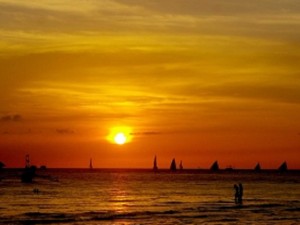What Makes Philippines the Heart of Asia
Philippine Daily Inquirer

The country’s
medical tourism industry is hoping to get another boost from the
soon-to-be-released “Philippines: The Heart of Asia” travel guide.
The Philippines established its Medical
Tourism Program back in 2006—and now, a little over six years later, we can say
that while results have not been as quick as first envisioned, the country’s
efforts to become a regional healthcare hub are slowly but surely bearing fruit.
A few years ago, the country was
re-launched as a medical tourism destination under the brand “Philippines: The
Heart of Asia” and the tag remains as true today as it was before. The
Philippines really is The Heart of Asia in more ways than one.
As the Department of Tourism meets with
success in presenting the country as one of the most desirable destinations in
the region, especially through its “It’s More Fun in the Philippines”
campaign—it will be recalled that the Philippines was included in several
international “best destinations” lists in 2012—it can be reasonably expected
that this will also help highlight the Philippines’ strong points as a medical
tourism, healthcare, and wellness destination.
Hearts in the right place
Various research studies show
that patients’ recover faster and feel happier when they receive compassionate
care. Compassionate care, unfortunately, is often overlooked as more and more
hospitals overseas struggle to save on costs and increase efficiency—this is the
reason why Filipino nurses are in such demand the world over: Filipino nurses
are not simply competent but also friendly, cheerful, caring, and
compassionate.
Friendliness, compassion, caring,
and cheerfulness are aspects of Filipino culture that every Filipino grows up
with and imbibes. He or she learns it from parents, siblings, relatives and
friends. This is because most Filipinos value relationships more than material
possessions. Whether rich or poor, strong family bonds and smooth, mutually
beneficial relationships among relatives and friends define the Filipino way of
life.
Foreigners who visit the country as
tourists, work here as expats, or choose it as their second home after
retirement, all discover the warmth and hospitality that are unique to the
Filipinos. These are attributes that medical tourism travelers discover when
they receive treatment in the country’s hospitals and clinics.
English fluency
English is widely spoken in the
Philippines as one of its official languages. English is the language used in
education and business, and Filipinos in government agencies and the service
industry are fluent in it. There are many English-language publications in the
Philippines, including the major newspapers and magazines. There are also many
English-language programs on television and Hollywood movies are regularly shown
in theaters. Foreigners who speak English will have no difficulty relating to
and transacting with Filipinos.
Top-notch healthcare facilities
Filipino doctors are expertly
trained in the Western medical tradition and are up-to-date with the latest
advances in medical science. Many of them have trained overseas, including the
United States and Europe, and are affiliated with medical organizations in those
countries.
The country’s top public and private
hospitals are equipped with the latest in medical tools, machines, and
technologies—the same equipment, if not better, as those found in the U.S. and
Europe. The high standards of their facilities assure medical tourists that they
are getting the same quality care, or better, as they would receive from their
home countries.
This same high quality of care is found in
the Philippines’ top specialty clinics that offer dental and aesthetic
procedures.
Tropical paradise
With more than 7,000 islands in
its archipelago, the Philippines is home to beaches and seaside resorts that
provide relaxing, refreshing tropical paradise settings. There are natural
landscapes of breathtaking beauty in the highland regions. Medical travelers
will discover many picturesque places where they can enjoy their recovery.
Together with these various natural
settings, the Philippines also offers all the modern conveniences needed for
21st century living. From
high-tech telecoms networks to cable TV, to Internet service, and highly
urbanized, cosmopolitan areas with malls retail complexes offering local
products and international brands.
World
cuisine
Filipino food is a blend of
Western and Eastern influences that include Spanish, American, Chinese, and
Indian cuisines. With such a sophisticated palate, Filipinos easily welcomed the
entry of Japanese, Korean, Thai, Italian and Continental food in the culinary
scene. As a result, there are now so many different dining establishments that
offer a gamut of authentic, gourmet fare.
More
work ahead
As more of the country’s top
hospitals make considerable investments in their personnel and facilities, the
benefits to Filipino and foreign patients will also increase. There really is no
other way to help the Philippines become a regional medical tourism hub except
to make sure that its healthcare facilities are world-class.
One very important area that more
Philippine hospitals need to get into is international accreditation. This
accreditation is the most credible certification of a hospital’s, clinic’s, or
wellness facility’s world-class quality standards.
When we talk about world-class healthcare
certification or accreditation for hospitals and other healthcare facilities, we
usually refer to accrediting bodies like JCI, NABH International, Accreditation
Canada and others that are affiliated with the International Society for Quality
in Healthcare (ISQua). The ISQua is the world body that accredits these
accrediting bodies.
One ISQua-accredited body that has been
giving generous support to Philippine hospitals is NABH International. Through
its local affiliate, HealthCORE, the NABH International has been giving
workshops to Filipino hospital administrators to help them learn how to meet
ISQua standards, and assist them in the actual process of accreditation.
The success of the Department of Tourism’s
campaign plus the increasing number of foreign patients being treated in the
Philippines top hospitals prove that the country still has a bright future and
great potential to be a medical, health, and wellness hub in the region.
To fulfill that potential, all
stakeholders in the healthcare and travel sectors must get their acts together.
Only then will the world truly realize that the Philippines is the Heart of
Asia—a heart that gives care, compassion, life, love, and healing to those in
need. – Ramil Digal Gulle,
contributor










